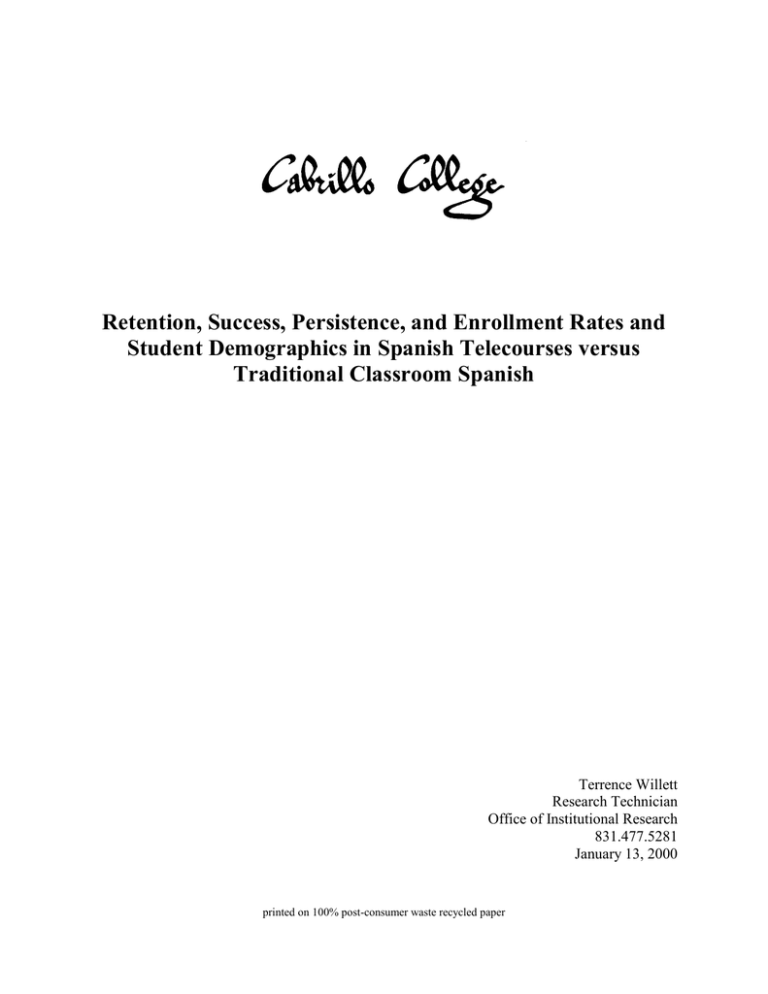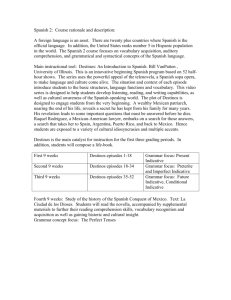Retention, Success, Persistence, and Enrollment Rates and
advertisement

Retention, Success, Persistence, and Enrollment Rates and Student Demographics in Spanish Telecourses versus Traditional Classroom Spanish Terrence Willett Research Technician Office of Institutional Research 831.477.5281 January 13, 2000 printed on 100% post-consumer waste recycled paper Retention, Success, Persistence, and Enrollment Rates and Student Demographics in Spanish Telecourses versus Traditional Classroom Spanish Terrence Willett, Research Technician Office of Institutional Research January 13, 2000 Summary This report compares retention, success, and persistence rates between Spanish telecourses (Destinos) and traditional classroom Spanish. Beginning Spanish courses in general have significantly lower retention and success rates than advanced Spanish. Destinos rates are mostly below classroom rates although the gap narrows in more advanced courses. Overall Destinos persistence was initially higher than classroom courses but has shown a significant downward trend over time of 5.5% per term and is now below classroom persistence rates. Further, enrollment in all Spanish classes in this study has been declining even though Cabrillo College’s enrollment has been increasing. Destinos students appear demographically distinct from classroom students being more likely to be older full time professionals or homemakers with degrees. It may be that Destinos is attracting students who would not otherwise be able to take Spanish but who also have more constraints inhibiting their scholastic performance. As Destinos students differ from classroom students, success, retention, and persistence comparisons may not be complete or appropriate measures of telecourse effectiveness. Introduction Distance learning is becoming increasingly used as a method of teaching students. Foreseen benefits include convenience for working students, outreach to underserved areas, and ability to accommodate our State’s growing number of students (California Postsecondary Education Commission). As this is a new technique of instruction, we must compare distance learning’s effectiveness to traditional methods of instruction. In this report, we examine retention, success, and persistence rates between distance learning students and traditional classroom students. Methods I studied all 5155 students who had taken Spanish 1, 1A, 1B, 2, 2A and/or 2B between Spring 1996 and Spring 1999 and received a grade of A, B, C, D, F, CR, NC, W, or I (CR = credit, NC = no credit, W = withdrawal, I = incomplete). Spanish classes included the distance learning Destinos telecourses for Spanish 1A, 1B, 2A, and 2B, traditional classroom Spanish 1 and 2, and traditional weekend classroom Spanish 1A and 1B. Retention is the proportion of students who received a grade of A, B, C, D, F, CR, NC, or I or more simply, those who completed the course. Success is the proportion of students who received a grade of A, B, C, or CR. Persistence for Destinos is the proportion of students who completed Spanish 1B and Spanish 2A in consecutive terms. Persistence for classroom Spanish is the proportion of students who completed Spanish 1 or 1B and Spanish 2 in consecutive terms. Those who waited one or more terms were not counted for persistence nor were those who may have switched between a telecourse and classroom course. 1 Results Retention and success rates are presented in Table 1 and shown in Figures 1 through 4. Likelihood analyses showed significant differences in retention rates for all terms except Fall 1996 and Spring 1999 (see Table 2). Classroom Spanish 2 generally had higher than expected retention while classroom Spanish 1 had generally lower than expected retention (see Table 3). Destinos courses vary with Spanish 1A showing a downward trend. Significant differences in success rates occur in all terms (see Table 4). Classroom Spanish 2 consistently had higher than expected success rates while Destinos Spanish 1A had very consistent lower than expected success rates (see Table 5). Persistence rates are initially higher for Destinos courses but then fall below classroom persistence rates (see Table 6) although the mean and median persistence for Destinos remains above classroom rates (see Table 7). Destinos persistence shows a significant linear decline of 5.5% per term on average while classroom persistence shows no significant linear increase or decrease over the same time period (see Table 8 and Figure 5). Enrollment for all Spanish classes in this study have been generally declining by an average of 2.6 students per term even while Cabrillo College enrollment has been increasing by an average of 19.2 students per term (see Table 9 and Figure 6). Classroom Spanish 1 declines do not appear to be due to Destinos drawing away students nor does Destinos appear to be slowing the decline as enrollment rates are not significantly different between Spanish 1 with and without Destinos 1A included using a Mann-Whitney U-test (Z = -0.622, p = 0.534) (see Figure 7). Crosstabulations of demographics between Spanish 1 and Destinos Spanish 1A students (not presented) show that a higher proportion of Destinos students are female, white, over 40, native English speakers, expecting to be employed either full time or not at all, have an advanced degree, and have “update job skills” or “educational development” as a goal. There does not appear to be a relation between geography and course. Discussion Beginning Spanish classes of either type appear to have in general lower retention and success rates while more advanced Spanish classes, especially classroom Spanish, seem to have overall higher retention and success. This could be due to students having greater commitment as they begin progressing through levels of Spanish or perhaps that stronger students are more likely to be those who progress. Differences in retention between Destinos and classroom Spanish appear to follow similar patterns to persistence where Destinos Spanish 1A begins higher than Spanish 1 but later declines. Success for Destinos is lower than equivalent classroom Spanish in all cases except for Fall 1997 Destinos Spanish 1B and Spring 1999 Destinos 1A compared to weekend Spanish 1A. The initial high persistence of Destinos has eroded to below traditional classroom persistence. Classroom Spanish appears to have established a stable persistence level while it seems we cannot yet tell where or whether Destinos courses will settle. Enrollments for all Spanish classes are declining and Destinos classes do not appear to be adding or detracting but rather are following the decline. One goal of Destinos was to reach out to students who would not otherwise be able to take Spanish because of lifestyle constraints. Comparing Destinos 1A to classroom Spanish1, we find that a higher proportion of Destinos students are female, white, over 40, native English speakers, expecting to be employed either full time or not at all, have an advanced degree, and have “update job skills” or “educational development” as a goal. There does not seem to be a difference in Destinos versus classroom Spanish enrollment by geographic region. It appears that Destinos may differentially attract older professional and homemaking students whose home and work demands inhibit physically attending classes. Because Destinos students appear to differ from classroom students, it may be that success, retention, and persistence rates may not be complete or appropriate measures of effectiveness. It may be that simply the attraction of new students is the desired outcome. Minimum goals for enrollment, retention, success, and persistence are probably appropriate but they should probably not be expected to be as high as classroom rates. 2 Table 1. Retention and Success Rates for Destinos and Classroom Spanish Term Spring 96 Fall 96 Spring 97 Fall 97 Spring 98 Fall 98 Spring 99 DSPAN1A DSPAN1B DSPAN2A DSPAN2B SPAN1 SPAN1B SPAN2 Term Total DSPAN1A DSPAN1B DSPAN2A DSPAN2B SPAN1 SPAN2 Term Total DSPAN1A DSPAN1B DSPAN2A DSPAN2B SPAN1 SPAN1A SPAN1B SPAN2 Term Total DSPAN1A DSPAN1B DSPAN2A DSPAN2B SPAN1 SPAN1A SPAN1B SPAN2 Term Total DSPAN1A DSPAN1B DSPAN2A DSPAN2B SPAN1 SPAN1A SPAN1B SPAN2 Term Total DSPAN1A DSPAN1B DSPAN2A DSPAN2B SPAN1 SPAN1A SPAN1B SPAN2 Term Total DSPAN1A DSPAN1B DSPAN2A DSPAN2B SPAN1 SPAN1A SPAN1B SPAN2 Term Total Retention # 53 17 6 7 297 9 187 576 50 14 29 2 359 127 581 52 13 15 13 280 22 12 128 535 17 10 9 1 303 22 14 151 527 29 14 8 9 262 14 13 136 485 28 10 10 3 310 26 21 132 540 27 13 5 1 250 16 10 143 465 % 80.3 89.5 66.7 77.8 64.4 56.3 77.9 70.2 78.1 66.7 82.9 100.0 74.2 72.2 74.3 94.5 72.2 78.9 100.0 67.3 95.7 75.0 73.6 72.9 39.5 76.9 47.4 16.7 60.8 91.7 63.6 78.2 64.4 59.2 66.7 44.4 100.0 68.9 53.8 86.7 80.0 70.5 53.8 50.0 66.7 100.0 74.9 65.0 87.5 83.0 74.3 87.1 68.4 55.6 50.0 78.4 80.0 90.9 81.7 79.4 Success # 26 10 3 5 255 9 177 485 19 8 14 279 109 429 24 7 8 8 220 12 11 120 410 16 9 9 1 250 13 7 137 442 22 8 8 8 216 14 9 127 412 15 8 9 3 240 23 16 118 432 18 8 4 1 208 7 6 142 394 DSPAN = Destinos Spanish Telecourses SPAN = Traditional Classroom Spanish 3 Total % 39.4 52.6 33.3 55.6 55.3 56.3 73.8 59.1 29.7 38.1 40.0 0.0 57.6 61.9 54.9 43.6 38.9 42.1 61.5 52.9 52.2 68.8 69.0 55.9 37.2 69.2 47.4 16.7 50.2 54.2 31.8 71.0 54.0 44.9 38.1 44.4 88.9 56.8 53.8 60.0 74.7 59.9 28.8 40.0 60.0 100.0 58.0 57.5 66.7 74.2 59.4 58.1 42.1 44.4 50.0 65.2 35.0 54.5 81.1 67.2 66 19 9 9 461 16 240 820 64 21 35 2 484 176 782 55 18 19 13 416 23 16 174 734 43 13 19 6 498 24 22 193 818 49 21 18 9 380 26 15 170 688 52 20 15 3 414 40 24 159 727 31 19 9 2 319 20 11 175 586 Figure 1. Retention for Destinos and Classroom Spanish 1. Destinos 1A Destinos 1B Classroom Spanish 1 100.0 90.0 Retention Rate 80.0 70.0 60.0 50.0 40.0 30.0 20.0 10.0 0.0 Spring 96 Fall 96 Spring 97 Fall 97 Spring 98 Fall 98 Spring 99 Figure 2. Retention for Destinos and Classroom Spanish 2. Destinos 2A Destinos 2B Classroom Spanish 2 100.0 90.0 80.0 Retention Rate 70.0 60.0 50.0 40.0 30.0 20.0 10.0 0.0 Spring 96 Fall 96 Spring 97 Fall 97 Spring 98 Fall 98 Spring 99 4 Figure 3. Success for Destinos and Classroom Spanish 1. Success Rate Success Rate Destinos1A 1A Destintos Destinos1B 1B Destinos Classroom Classroom Spanish Spanish 11 100.0 100.0 90.0 90.0 80.0 80.0 70.0 70.0 60.0 60.0 50.0 50.0 40.0 40.0 30.0 30.0 20.0 20.0 10.0 10.0 0.0 0.0 Spring Fall 96 Spring Spring Fall 96 Spring 96 97 96 97 Fall 97 Fall 97 Spring Spring 98 98 Fall 98 Fall 98 Spring Spring 99 99 Figure 4. Success for Destinos and Classroom Spanish 2. Destinos 2A Destinos 2B Classroom Spanish 2 100.0 90.0 80.0 Success Rate 70.0 60.0 50.0 40.0 30.0 20.0 10.0 0.0 Spring 96 Fall 96 Spring 97 Fall 97 Spring 98 Fall 98 Spring 99 5 Table 2. Significance of differences in retention rates between courses. Term Spring 96 Fall 96 Spring 97 Fall 97 Spring 98 Fall 98 Spring 99 Likelihood Ratio 23.62 4.184 40.714 49.881 28.334 28.903 7.809 df 6 5 7 7 7 7 7 p 0.001 0.523 < 0.0005 < 0.0005 < 0.0005 < 0.0005 0.35 Table 3. Comparison of observed retention rates to those expected if all courses were equal. Term Spring 96 Fall 96 Spring 97 Fall 97 Spring 98 Fall 98 Spring 99 DSPAN1A DSPAN1B DSPAN2A DSPAN2B SPAN1 higher higher lower SPAN1A higher lower higher higher lower lower lower lower higher lower higher lower lower SPAN1B SPAN2 higher higher higher higher lower Table 4. Significance of differences in success rates between courses. Term Spring 96 Fall 96 Spring 97 Fall 97 Spring 98 Fall 98 Spring 99 Likelihood Ratio 38.446 30.339 22.272 40.674 32.353 42.296 35.354 df 6 5 7 7 7 7 7 p < 0.0005 < 0.0005 0.002 < 0.0005 < 0.0005 < 0.0005 < 0.0005 Table 5. Comparison of observed success rates to those expected if all courses were equal. Term Spring 96 Fall 96 Spring 97 Fall 97 Spring 98 Fall 98 Spring 99 DSPAN1A DSPAN1B DSPAN2A DSPAN2B SPAN1 lower lower lower higher lower lower lower lower lower lower lower lower lower 6 SPAN1A SPAN1B lower SPAN2 higher higher higher higher higher higher higher Table 6. Persistence rates for moving from Spanish 1 to Spanish 2 in consecutive terms. Persistence Destinos % 31.6 19.0 22.2 15.4 9.5 0.0 Spring 1996 to Fall 1996 Fall 1996 to Spring 1997 Spring 1997 to Fall 1997 Fall 1997 to Spring 1998 Spring 1998 to Fall 1998 Fall 1998 to Spring 1999 Classroom % 12.6 17.8 14.2 13.7 9.4 20.1 n 19 21 18 13 21 20 n 475 484 430 520 395 438 Table 7. Average persistence rates for moving from Spanish 1 to Spanish 2 in consecutive terms. Destinos 16.3 10.9 17.2 Mean sd Median Classroom 14.6 3.8 14.0 Figure 5. Persistence of Spanish students in consecutive terms. Destinos Classroom Percent moving from Spanish 1 to Spanish 2 35.0 30.0 25.0 20.0 15.0 10.0 5.0 0.0 Spring 1996 to Fall 1996 Fall 1996 to Spring 1997 Spring 1997 to Fall 1997 Fall 1997 to Spring 1998 Table 8. Regression coefficients of persistence trends. Destinos Classroom . R2 0.906 0.027 b -5.523 0.337 F(1,4) 38.719 0.113 p 0.003 0.754 7 Spring 1998 to Fall 1998 Fall 1998 to Spring 1999 Table 9. Enrollment of Destinos and Classroom Spanish. Term DSPAN1A DSPAN1B SPAN1 Spring 1993 Fall 1993 Spring 1994 Fall 1994 Spring 1995 Fall 1995 Spring 1996 Fall 1996 Spring 1997 Fall 1997 Spring 1998 Fall 1998 Spring 1999 58 60 40 67 64 55 46 50 57 33 SPAN1A 567 638 489 567 468 488 490 497 431 521 400 437 333 22 21 21 18 13 22 22 19 SPAN1B 20 1 16 28 28 31 40 20 26 22 15 24 11 SPAN2 DSPAN2A DSPAN2B Total Total Spanish Cabrillo 309 876 13018 278 916 12617 251 740 13075 227 852 12782 236 786 13201 205 777 12154 248 9 10 861 13851 183 36 2 803 12791 179 19 13 769 13656 209 21 7 867 13606 181 18 9 726 13575 171 15 3 769 13778 180 9 2 607 13918 Figure 6. Enrollment for Cabrillo College and for all Spanish classes in Table 9. 14500 Cabrillo College 14000 Figure 7. Enrollment of Classroom Spanish 1 with and without Destinos Spanish 1A included. 700 600 500 400 300 SPAN1 200 SPAN1 + DSPAN1A 100 0 Fall Spring Fall Spring Fall Spring Fall Spring Fall Spring 1994 1995 1995 1996 1996 1997 1997 1998 1998 1999 8 Spring 1999 Fall 1998 Spring 1998 Fall 1997 Spring 1997 Fall 1996 Spring 1996 Fall 1995 Spring 1993 Spring 1999 Fall 1998 Spring 1998 Fall 1997 Spring 1997 Fall 1996 Spring 1996 Fall 1995 Spring 1995 Fall 1994 Spring 1994 11000 Fall 1993 11500 Spring 1995 12000 Fall 1994 12500 Spring 1994 13000 Fall 1993 Enrollment 13500 Spring 1993 Enrollment Spanish 1000 900 800 700 600 500 400 300 200 100 0



